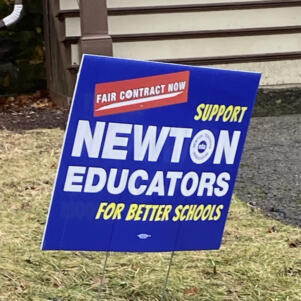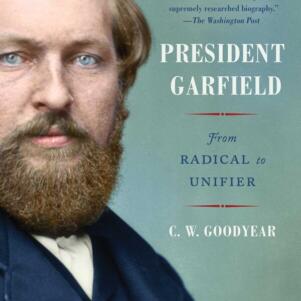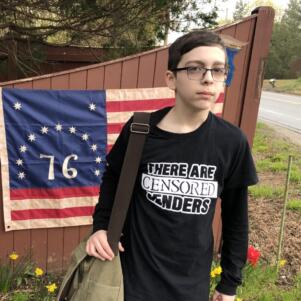High-Five This: Cops Not Welcome At Northampton Schools Because Illegal Immigrants May Feel Antsy
By NBP Staff | February 22, 2017, 6:55 EST
 Northampton police officers offer high-fives to students at an elementary school in Northampton in mid-December 2016.
Photos from Northampton Police Department Facebook page
Northampton police officers offer high-fives to students at an elementary school in Northampton in mid-December 2016.
Photos from Northampton Police Department Facebook page Police in the western Massachusetts city of Northampton won’t be offering high-fives to elementary students as they come into school anymore because some residents think it may make illegal immigrants feel uncomfortable.
The High Five Friday program initially got a good reaction from school officials, students, and parents when it started in December.
But when Police Chief Jody Kasper described the program to the Northampton School Committee last month she got a mixed response. Some of the all-white committee members expressed concerns that illegal immigrants and members of racial minorities may be fearful of seeing police at their school.
“Shortly after the meeting, NPD was asked to pause the program, which we did,” the Northampton Police Department said in a Facebook posting this past weekend.
After a follow-up meeting with about 12 to 15 people, police and school officials decided to scrap the program.
“NPD really enjoyed greeting kids as they arrived at school. But, as much as we enjoyed the visits, we also took time to listen to the thoughts of some school committee members, school staff, and past and present parents/families. For a large portion of our population this program may not seem controversial. However, we cannot overlook the fact that this program may be received differently by some members of our community,” the police said in the Facebook posting.
Two Northampton police captains got the idea when they attended the International Association of Chiefs of Police meeting in San Diego last fall. It grew out of a task force report published in the wake of the racially charged riots in Ferguson, Missouri in 2014 after a white police officer shot and killed a black man who had just robbed a convenience store.
Northampton police saw giving high-fives as a way to engage with kids in a friendly manner in order to develop positive relationships with them of the sort that the post-Ferguson task force report recommends.
“We liked it because we thought it would be easy to implement in our community. It was definitely youth-oriented. It was inexpensive-slash-free, which we always value. And it was something we thought would be good for both the students and the officers involved,” Kasper told the Northampton School Committee during a 25-minute discussion of the program on January 12.
(You can watch the discussion here, from 41:59 to 1:06:56.)
Kasper got permission from the superintendent of schools and the principals to have police officers give students at one of Northampton’s four elementary schools a high-five on their way into the building on one Friday a month, with police rotating among the schools every week.
The police chief said she took precautions to try to make children feel comfortable. The principals announced the program in their newsletters to parents, and police parked their marked cruisers far from the entrance of each school.
“One of our concerns was certainly that there may be kids who might not want to high-five a cop. I understand that. So the officers are told, you know, don’t chase down kids and make them high-five you. Stand in a line on one side, and kids can pass by without high-fiving if want to,” Kasper told the School Committee.
Kasper said students seemed to like it and she described a few instances where police got good feedback.
That wasn’t reassuring for School Committee member Molly Burnham.
“I think it came up sort of suddenly for a lot of us, and that was a little upsetting,” Burnham said during the meeting.
She said she didn’t see quantitative evidence that the program was providing educational benefit.
“Saying that, I think that one of my questions is that I feel, like, I actually have no idea if it’s working. I don’t know what the rubric is. I have kids in the school, you’ve given me anecdotal evidence. And I feel very, like, O.K., what is the goal? How do we assess it? I mean, we’re a school system. That’s kind of what we’re doing. And to just say, ‘Some kids saw some police officers, and, you know,’ I just, I can’t quite get my teeth into it,” Burnham said.
Kasper acknowledged that it’s not always easy to gauge the success of outreach.
“I think a lot of our community research programs are hard to measure the impact,” Kasper said. “… It’s hard to measure impact, without doing a really wide sort of survey on that.”
School Committee member Laura Fallon said she was “ambivalent” about the program, because she was worried that students on the margins of society may not give negative feedback to it.
But School Committee member R. Downey Meyer praised the police high-five program.
“The police are an important public institution. And to leave them out, to have the only contact be a negative contact … leaves people with a bad impression of police, and actually leads to more harm when people encounter police. And so I think that a thoughtful interaction like this … is a positive thing, and I would hope that we would encourage it,” Meyer said. “… I hope that we don’t say, ‘Because we don’t measure it, we don’t do it’.”
School Committee member Ann Hennessey said her kids loved the high-five program, but that it’s the responsibility of what she called the school district’s “white community of leaders” to reach out to “communities of color” to see how they feel about it.
“I feel like I’m almost looking in a fish tank and making these decisions. … Many of us are talking about communities that we’re not checking in with there,” Hennessey said.
Northampton is a so-called sanctuary city. Mayor David Narkewicz, who is also chairman of the School Committee, issued an executive order in August 2014 limiting cooperation by local police with federal immigration authorities.
The mayor didn’t comment directly on the high-five program during the meeting.
A student representative to the School Committee, Elena Frogameni, asked Kasper if Northampton police receive training about racial bias.
Kasper said last year Northampton police officers received 755 hours of training on “biased-based policing.”
“We expose that sort of training to all of our staff,” Kasper said
This past Saturday, Northampton police tried to emphasize the positive in announcing the end of the program on Facebook:
“Luckily, we still accept high fives, low fives, and fist bumps. If you see any of us out there on the streets, feel free to ask for one!”











